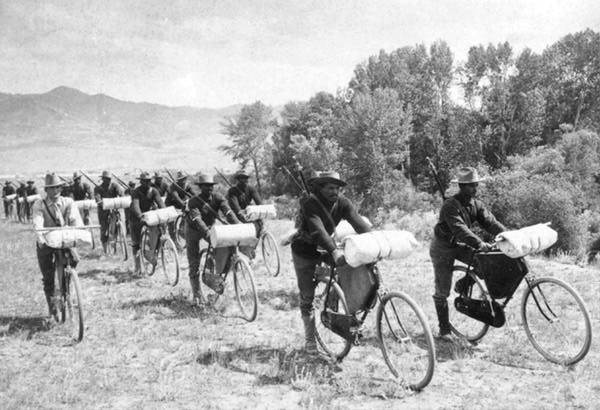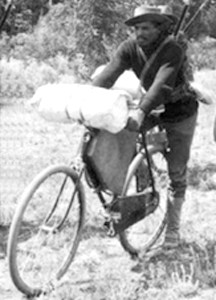Montana Mountain Biking: The First Expedition
In Western Montana, dirt roads veer off main thoroughfares about as often as branches on a tamarack, which makes for great bicycling. And it's been that way here in the heart of the Northern Rockies for a century.
Although the first people to take credit for the mountain bike craze claim to have conquered steeps and narrows in the past two decades, the REAL first mountain bikers conquered the West 100 years ago. And they weren't white males with a median age of 40 and a median income of $50,000. They were 20 black men on soldiers' wages who burrowed themselves spokes-deep into the Rocky Mountains and Midwestern plains of the United States.
On June 14, 1897, Lieutenant James Moss, U.S. Army, led his bicycle corps of the 25th Infantry, from Fort Missoula, Montana, up wagon trail and Indian path, to St. Louis, Missouri, arriving July 16, 1897. As cycle tourists go, these guys had grit! They jolted down dusty trails and nonexistent paths of the Old West, often pushing and carrying their one-speed steel steeds.
 |
"Bad Roads, Head Winds, Alkali Water, Rattlesnakes and Many Other Pleasures," the headlines read.
The military put man and mechanism through such rigors in an attempt to find a replacement for horses. An 1894 prediction estimated that soon the U.S. would have an army of 50,000 on bicycles, stationed throughout the country. Straddling the heyday of bicycles in the late 19th century, Lt. Moss and company's research and development led to numerous manufacturing advances in bicycle technology.
Across the nation, two-wheelers embarked on horse-manured streets and threaded past wagon-clogged avenues like never before. Even in the frontier of Missoula, bikes were all the rage. An April 1894 issue of the Daily Missoulian noted that, "...half of the people at the fort are on bicycles and a person without a wheel is out of the times as it were."
More bikes than other cities
Today, Missoula brags that 65 percent of its 47,000 residents own bikes and that bicycle commuting in Missoula is 17 times the national average! Thus, Missoula is an appropriate home for a permanent display on the 25th Infantry Bicycle Corp. At the Ft. Missoula Museum, an entire wing is dedicated to the bicycle exhibit. Displays include black-and-white photographs of the troops visiting Yellowstone National Park. Uniforms, rifles and a bicycle accompany other details of their travels.
Jump fence!
A hundred years ago, the idea to test the velocipede came from General Nelson A. Miles who recommended the establishment of the all-black 25th Infantry Bicycle Corps, led by white officers. The troops spent the summer of 1896 in intensive training. At Moss' command, "Jump Fence!" the soldiers scaled a nine-foot obstacle by leaning the bike against the fence, standing on the bike's seat, climbing to fence top, then pulling the bicycle up and over.
| Spaulding manufacturing, at the forefront of cycle design of the day, donated 22 bikes
for the test. Spaulding equipped their top-of-the-line two-wheelers with steel rims
instead of wooden ones, gear cases protecting chains, and hard leather frame cases for
rations, spare parts and tools. When the men mounted the two-wheelers, they mounted the 70-plus pounds of loaded bike, cranking east toward St. Louis. Standard military rations filled their bags: flour, baking powder, dry beans, baked beans, coffee, sugar, bacon, canned beef, salt, and pepper. Each man carried two-days worth of food. Supplies awaited them along the route. However, the planned 50 miles per day in challenging terrain and weather left the men shy of their destinations on several occasions -- and hungry. "Our course lay up the long hill with a head wind confronting us. It was a long walk to the top. The wind increased in velocity and together with a very long hill, we were completely tired out," wrote accompanying Missoula newspaperman, Edward Boos. |
 Photos Courtesy of: Universtiy of Montana Library |
Runaways
The soldiers had several "runaways," as Boos called the bikes' inclination to zoom off uncontrollably. A few falls and minor mishaps occurred, he noted, but "no injuries or breaks of importance."
They slogged from fort to fort across the state and across the West. July 10's dispatch told of central Montana's lack of adequate roads. "When nearing Beaver Creek, the road became impassable for bicycles and the order was given to keep to the railroad track," wrote Boos. "We tried this plan for several miles and were nearly jolted to pieces when the good roads again appeared and which we were glad to use."
Boos tells of pushing their metal steeds for miles, up hills, through mud bogs and across washouts. At trip's end he estimated that they actually pushed their bikes from 300 to 400 miles of the entire trip. Although quite positive in reporting, Moss, the 25th Infantry, and the bicycle never achieved high military status. The troops were sent to Cuba, and the combustion engine skidded into the military and the world's hearts.
| Jean Arthur |
| Jean Arthur writes from her home in Whitefish, Montana, where she lives with her
husband and children. Her first book, Hellroaring: FiftyYears on The Big Mountain
was released last winter by Whitefish Editions. For information on book orders, email: [email protected] |